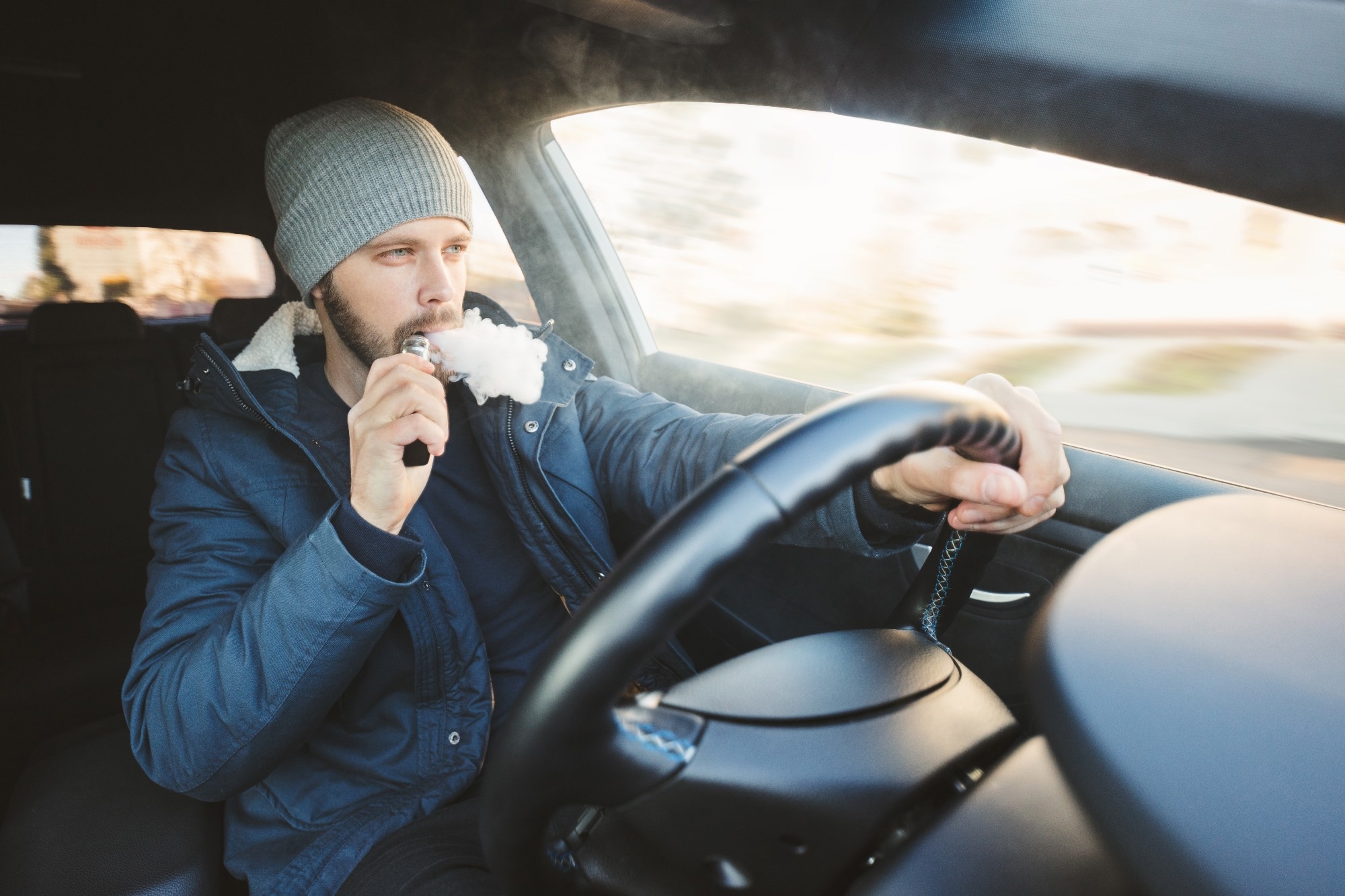A recent International Journal of Legal Medicine study assesses how cannabinoid levels in the blood affect driving after single or repetitive vaporization of cannabis rich in cannabidiol (CBD).
 Study: Effect of vaporizing cannabis rich in cannabidiol on cannabinoid levels in blood and on driving ability – a randomized clinical trial. Image Credit: And-One / Shutterstock.com
Study: Effect of vaporizing cannabis rich in cannabidiol on cannabinoid levels in blood and on driving ability – a randomized clinical trial. Image Credit: And-One / Shutterstock.com
Background
Cannabis is a widely consumed and regulated substance that is extracted from Cannabis sativa. The key psychoactive constituent of cannabis is Δ9 - tetrahydrocannabinol (THC). Another phytoconstituent of C. sativa is cannabidiol (CBD), which is not considered intoxicating.
Many industries use different cannabis varieties for the development of different commercial products. Typically, plant varieties like hemp contain less than 1% THC.
Global acceptance of the sale of products with high CBD and low THC content could bypass control by drug laws. For example, Switzerland allows the selling, possession, and consumption of cannabis with a THC threshold of 1%.
It is important to assess the driving-related ability of a person to determine whether they are fit to drive safely and follow traffic rules. Many factors can limit an individual’s ability to drive safely including fatigue, medication, THC use, and alcohol consumption.
Most countries throughout the world follow a zero-tolerance policy if THC is detected in a driver, whereas other countries like Switzerland implement similar regulations at two levels. These include a THC threshold of 1.5 µg/L in whole blood, which can have legal consequences only if the driver violates traffic safety rules or causes an accident.
THC concentrations above 1.5 µg/L are punishable independent of the consequences. Due to a lack of standardized measurements for THC, a higher limit of about 30% is practiced in Switzerland.
Smoking is the most common manner of cannabis use, which is associated with lower bioavailability and reproducibility than vaporizing. Consumption of cannabis varieties with 0.8-0.94% THC content can lead to 4.5-6.8 ng/mL THC concentrations in the whole blood. Another study indicated that a repeated exposure of 0.16 % THC led to 10.8 µg/L THC levels in serum.
These findings raise concerns regarding the effect of low THC/CBD-rich cannabis products on driving. To date, there remains a lack of adequate evidence to determine THC levels that potentially impair driving ability.
About the study
The current study estimated THC and CBD levels in blood and assessed whether these levels impair an individual’s driving ability. Healthy participants between 18-65 years of age who had a valid driving license and were experienced smokers were recruited for the study. Any participant with a history of physical or psychiatric disease was excluded.
This prospective, double-blind, placebo-controlled, randomized, cross-over study involved two study arms. Whereas S1 investigated the driving ability of volunteers with a single consumption of two different cannabis products, S2 assessed volunteers with frequent cannabis consumption.
All participants received the same dose of interventional products through the Volcano medic® vaporizer. However, different interventional products were assessed, of which included Product 1 (300 mg of the cannabis variety Harley Quinn), Product 2 (300 mg of the cannabis variety V1 Haze), and Product 3 (300mg of placebo cannabis). Product 1 released 38 mg CBD and 1.8 mg THC, while Product 2 released 39 mg CBD and 0.6 mg THC.
The influence of these products on driving was assessed five hours after consumption. Blood samples were regularly obtained from the participants to estimate THC levels in whole blood. Driving ability was evaluated following a standardized and validated neuropsychological test system after one and three hours post-consumption.
Study findings
S1 and S2 comprised 27 and 20 participants, respectively. After placebo inhalation, no THC or CBD was detected in the participants’ blood samples. As compared to Product 2, Product 1 yielded significantly higher THC peak concentrations, thus demonstrating that the THC content of the product had an important role in peak concentration and detection durability.
After product 1 consumption, THC concentrations in whole blood decreased below 2.2 µg/L after 30 minutes and continued to decline to less than 1.5 µg/L after 1.5 hours. In 21% of participants, THC was detected up to five hours post-consumption.
Ten days of repetitive product 1 consumption was associated with reduced THC levels below 2.2 µg/L after 20 minutes and below 1.5 µg/L 40-50 minutes following cannabis consumption. In S2, 44% of the participants exhibited THC concentrations in the blood for at least five hours post-consumption.
Following product 2 use, THC levels immediately reached over 2.2 µg/L after vaporization in both S1 and S2, which dropped below 2.2 µg/L within five minutes. THC levels were detected in 12% and 10% of S1 and S2 participants at 1.5 and 2.5 hours, respectively.
Conclusions
It is imperative that consumers abstain from driving at least two hours after using cannabis products, as the study findings indicate that following this timeline will prevent crossing the Swiss THC legal limit. Importantly, the test used in this study was not sensitive enough to detect minor impairment, which might affect driving.
Journal reference:
- Egloff, L., Frei, P., Gerlack, K., et al. (2023) Effect of vaporizing cannabis rich in cannabidiol on cannabinoid levels in blood and on driving ability – a randomized clinical trial. International Journal of Legal Medicine. doi:10.1007/s00414-023-03076-0